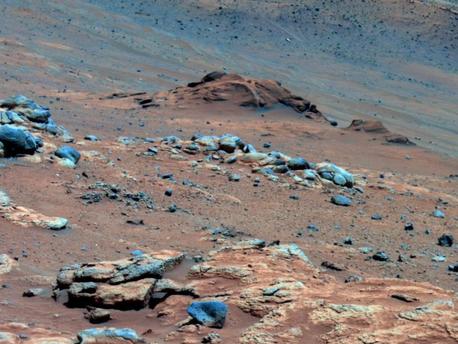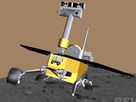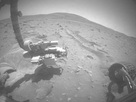PASADENA, Calif.
NASA Rover Finds Clue to Mars' Past and Environment for Life
 © NASA/JPL-Caltech/Cornell University
|
Lengthy detective work with data NASA's Mars Exploration Rover Spirit collected in late 2005 has confirmed that an outcrop called "Comanche" contains a mineral indicating that a past environment was wet and non-acidic, possibly favorable to life. Spirit used its panoramic camera to capture this view of the Comanche outcrop during the 689th Martian day, or sol, of the rover's mission on Mars (Dec. 11, 2005). The rover's Moessbauer spectrometer, miniature thermal emission spectrometer and alpha particle X-ray spectrometer each examined targets on Comanche that month. On June 3, 2010, scientists using data from all three spectrometers reported that about one-fourth of the composition of Comanche is magnesium iron carbonate. That concentration is 10 times higher than for any previously identified carbonate in a Martian rock. Carbonates originate in wet, near-neutral conditions but dissolve in acid. The find at Comanche is the first unambiguous evidence from either Spirit of its twin, Opportunity, for a past Martian environment that may have been more favorable to life than the wet but acidic conditions indicated by the rovers' earlier finds. In this image, Comanche is the dark reddish mound above the center of the view. The image is presented in false color, which makes some differences between materials easier to see. It combines three separate exposures taken through filters admitting wavelengths of 750 nanometers, 530 nanometers and 430 nanometers. The main Comanche outcrop is about 5 meters (16 feet) from left to right from this perspective. The paler material visible at bottom right is part of another outcrop, "Algonquin."
NASA's rovers have found other evidence of formerly wet Martian environments. However the data for those environments indicate conditions that may have been acidic. In other cases, the conditions were definitely acidic, and therefore less favorable as habitats for life.
Laboratory tests helped confirm the carbonate identification. The findings were published online Thursday, June 3 by the journal Science.
"This is one of the most significant findings by the rovers," said Steve Squyres of Cornell University in Ithaca, N.Y. Squyres is principal investigator for the Mars twin rovers, Spirit and Opportunity, and a co-author of the new report. "A substantial carbonate deposit in a Mars outcrop tells us that conditions that could have been quite favorable for life were present at one time in that place. "
Spirit inspected rock outcrops, including one scientists called Comanche, along the rover's route from the top of Husband Hill to the vicinity of the Home Plate plateau which Spirit has studied since 2006. Magnesium iron carbonate makes up about one-fourth of the measured volume in Comanche. That is a tenfold higher concentration than any previously identified for carbonate in a Martian rock.
"We used detective work combining results from three spectrometers to lock this down," said Dick Morris, lead author of the report and a member of a rover science team at NASA's Johnson Space Center in Houston."The instruments gave us multiple, interlocking ways of confirming the magnesium iron carbonate, with a good handle on how much there is."
Massive carbonate deposits on Mars have been sought for years without much success. Numerous channels apparently carved by flows of liquid water on ancient Mars suggest the planet was formerly warmer, thanks to greenhouse warming from a thicker atmosphere than exists now. The ancient, dense Martian atmosphere was probably rich in carbon dioxide, because that gas makes up nearly all the modern, very thin atmosphere.
It is important to determine where most of the carbon dioxide went. Some theorize it departed to space. Others hypothesize that it left the atmosphere by the mixing of carbon dioxide with water under conditions that led to forming carbonate minerals. That possibility, plus finding small amounts of carbonate in meteorites that originated from Mars, led to expectations in the 1990s that carbonate would be abundant on Mars. However, mineral-mapping spectrometers on orbiters since then have found evidence of localized carbonate deposits in only one area, plus small amounts distributed globally in Martian dust.
Morris suspected iron-bearing carbonate at Comanche years ago from inspection of the rock with Spirit's Moessbauerpectrometer, which provides information about iron-containing minerals. Confirming evidence from other instruments emerged slowly. The instrument with the best capability for detecting carbonates, the Miniature Thermal Emission Spectrometer, had its mirror contaminated with dust earlier in 2005, during a wind event that also cleaned Spirit's solar panels.
"It was like looking through dirty glasses," said Steve Ruff of Arizona State University in Tempe, Ariz., another co-author of the report. "We could tell there was something very different about Comanche compared with other outcrops we had seen, but we couldn't tell what it was until we developed a correction method to account for the dust on the mirror."
Spirit's Alpha Particle X-ray Spectrometer instrument detected a high concentration of light elements, a group including carbon and oxygen, that helped quantify the carbonate content.
The rovers landed on Mars in January 2004 for missions originally planned to last three months. Spirit has been out of communication since March 22 and is in a low-power hibernation status during Martian winter. Opportunity is making steady progress toward a large crater, Endeavour, which is about seven miles away.
Source: NASA
PASADENA, Calif.
NASA Rover Finds Clue to Mars' Past and Environment for Life
 © NASA/JPL-Caltech/Cornell University
|
Lengthy detective work with data NASA's Mars Exploration Rover Spirit collected in late 2005 has confirmed that an outcrop called "Comanche" contains a mineral indicating that a past environment was wet and non-acidic, possibly favorable to life. Spirit used its panoramic camera to capture this view of the Comanche outcrop during the 689th Martian day, or sol, of the rover's mission on Mars (Dec. 11, 2005). The rover's Moessbauer spectrometer, miniature thermal emission spectrometer and alpha particle X-ray spectrometer each examined targets on Comanche that month. On June 3, 2010, scientists using data from all three spectrometers reported that about one-fourth of the composition of Comanche is magnesium iron carbonate. That concentration is 10 times higher than for any previously identified carbonate in a Martian rock. Carbonates originate in wet, near-neutral conditions but dissolve in acid. The find at Comanche is the first unambiguous evidence from either Spirit of its twin, Opportunity, for a past Martian environment that may have been more favorable to life than the wet but acidic conditions indicated by the rovers' earlier finds. In this image, Comanche is the dark reddish mound above the center of the view. The image is presented in false color, which makes some differences between materials easier to see. It combines three separate exposures taken through filters admitting wavelengths of 750 nanometers, 530 nanometers and 430 nanometers. The main Comanche outcrop is about 5 meters (16 feet) from left to right from this perspective. The paler material visible at bottom right is part of another outcrop, "Algonquin."
NASA's rovers have found other evidence of formerly wet Martian environments. However the data for those environments indicate conditions that may have been acidic. In other cases, the conditions were definitely acidic, and therefore less favorable as habitats for life.
Laboratory tests helped confirm the carbonate identification. The findings were published online Thursday, June 3 by the journal Science.
"This is one of the most significant findings by the rovers," said Steve Squyres of Cornell University in Ithaca, N.Y. Squyres is principal investigator for the Mars twin rovers, Spirit and Opportunity, and a co-author of the new report. "A substantial carbonate deposit in a Mars outcrop tells us that conditions that could have been quite favorable for life were present at one time in that place. "
Spirit inspected rock outcrops, including one scientists called Comanche, along the rover's route from the top of Husband Hill to the vicinity of the Home Plate plateau which Spirit has studied since 2006. Magnesium iron carbonate makes up about one-fourth of the measured volume in Comanche. That is a tenfold higher concentration than any previously identified for carbonate in a Martian rock.
"We used detective work combining results from three spectrometers to lock this down," said Dick Morris, lead author of the report and a member of a rover science team at NASA's Johnson Space Center in Houston."The instruments gave us multiple, interlocking ways of confirming the magnesium iron carbonate, with a good handle on how much there is."
Massive carbonate deposits on Mars have been sought for years without much success. Numerous channels apparently carved by flows of liquid water on ancient Mars suggest the planet was formerly warmer, thanks to greenhouse warming from a thicker atmosphere than exists now. The ancient, dense Martian atmosphere was probably rich in carbon dioxide, because that gas makes up nearly all the modern, very thin atmosphere.
It is important to determine where most of the carbon dioxide went. Some theorize it departed to space. Others hypothesize that it left the atmosphere by the mixing of carbon dioxide with water under conditions that led to forming carbonate minerals. That possibility, plus finding small amounts of carbonate in meteorites that originated from Mars, led to expectations in the 1990s that carbonate would be abundant on Mars. However, mineral-mapping spectrometers on orbiters since then have found evidence of localized carbonate deposits in only one area, plus small amounts distributed globally in Martian dust.
Morris suspected iron-bearing carbonate at Comanche years ago from inspection of the rock with Spirit's Moessbauerpectrometer, which provides information about iron-containing minerals. Confirming evidence from other instruments emerged slowly. The instrument with the best capability for detecting carbonates, the Miniature Thermal Emission Spectrometer, had its mirror contaminated with dust earlier in 2005, during a wind event that also cleaned Spirit's solar panels.
"It was like looking through dirty glasses," said Steve Ruff of Arizona State University in Tempe, Ariz., another co-author of the report. "We could tell there was something very different about Comanche compared with other outcrops we had seen, but we couldn't tell what it was until we developed a correction method to account for the dust on the mirror."
Spirit's Alpha Particle X-ray Spectrometer instrument detected a high concentration of light elements, a group including carbon and oxygen, that helped quantify the carbonate content.
The rovers landed on Mars in January 2004 for missions originally planned to last three months. Spirit has been out of communication since March 22 and is in a low-power hibernation status during Martian winter. Opportunity is making steady progress toward a large crater, Endeavour, which is about seven miles away.
Source: NASA









